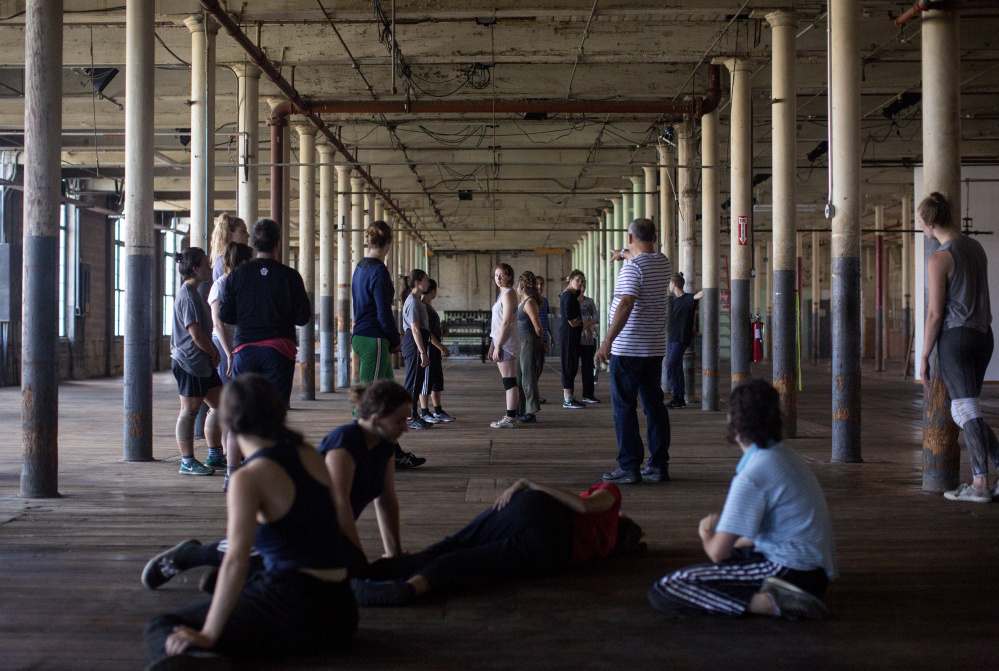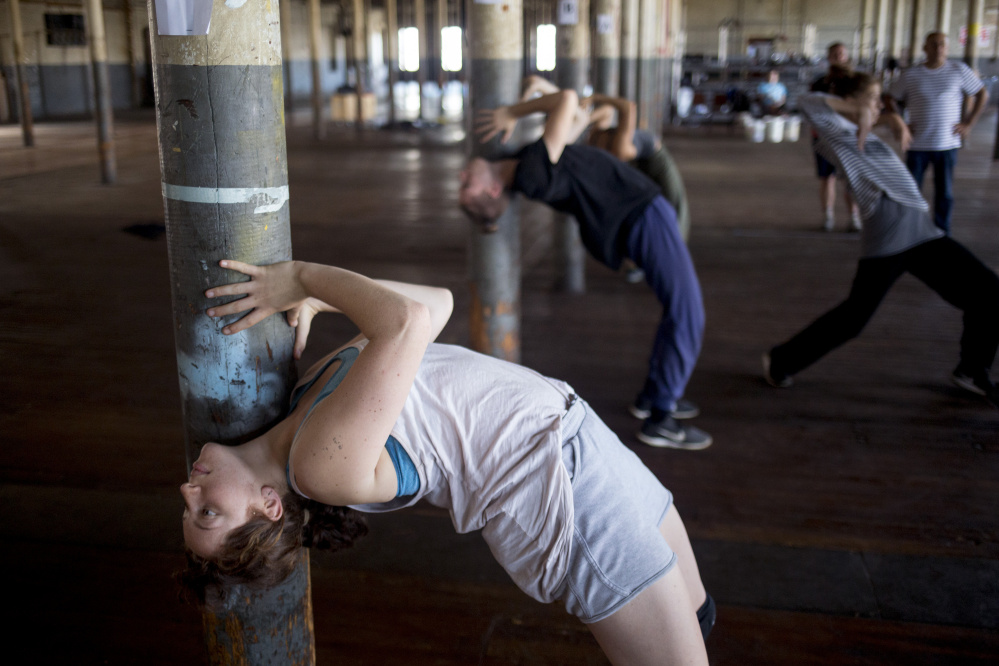“Mill Town,” a collection of multimedia movement presentations, brought Lewiston’s Bates Mill Complex to life on Thursday and Friday evenings.
The spaces breathed and pulsed with the endless toil of millworkers’ daily experience. Dancers’ garb matched the muted colors of the walls and columns, while their movements – rolling, climbing, reaching – echoed both the structure and the human lives of the mills.
With the vast rooms emptied of the deafening machinery of industry and the cotton lint that once filled the hot air and clung to workers’ damp skin, what remained was intertwined humanity, the mills’ true engine of production.
The site-specific, immersive work began in the courtyard between two buildings, with “Shift,” a prologue of tableaux in which young dancers posed and mimed with slubbers, large pipes used in preparing cotton. Festival director Laura Faure explained that slubbers also served as hiding places for underage workers when inspectors came around. In “Work,” also presented outside, the dancers’ movements poignantly included slipping into the slubbers.
Inside, the audience progressed through three installation series on three floors. “Water” featured film and sound of the fast-flowing water that powered the mills’ machinery, with dancers moving on either side of the projection. On the next floor, “Loom” had dancers weaving themselves around the room’s pillars and in and out of the window frames.
For “Prism,” the building’s echoing third floor was turned over to looping media and live-movement presentations, with viewers moving from one to another at their own pace. Several had dancers interacting with the building in ways that made the very bricks, wood and glass seem to move.
In one film, dancers crept across the wall of the iconic Lewiston Bleachery and Dye Works building. The projection was mirrored in two directions from a corner, for a kaleidoscopic effect in which bodies appeared out of nowhere in an endless flow.
In another projection, dancers rolled slowly along railroad tracks surrounded by trees while live dancers moved on the floor in front, later climbing up the brick wall through the filmed greenery.
In an adjacent space, the far wall had a projection of a room from a nearby building that has not yet been emptied of the remnants of industry. A lone woman step-danced amid frayed fabric and an unswept floor.
Between this projection and the audience’s walkway, the floor was covered with discarded shoe lasts used in nearby shoe factories. The drumming of the dancer’s feet, evoking the immigrant culture of many mill workers, gave dimension to the rubble of artifacts.
The finale, “Space,” took place on the third floor, between a double row of pillars extending to a vanishing point in the darkness at the far end of the room.
The lighting for this piece, by Michael Reidy, was amazing, creating spaces of shadow and darkness that made stillness seem more still and movement seem more alive. Dozens of dancers ran forward and back, suspended movement along the rows of pillars, looked searchingly into the light and fell to the floor in the shadows. The effect was enveloping.
“Mill Town” was four years in the making, conceived by Faure and choreographer/director Stephan Koplowitz, a multiple award-winning artist known for site-specific work in such venues as Grand Central Station and the New York Public Library.
Koplowitz worked with composer Todd Reynolds, who wrote and performed a sparse electronic score thematically punctuated by fiddle strings in homage to the millworkers’ Irish and French heritage.
The brilliantly integrated films were created by videographer Ellen Maynard and producer/technical designer Shawn Hove, and the flowing costumes were designed by Melody Eggen.
Performers included a “core company” of professionals, dancers from the Bates Professional Training Program and young dancers from the Bates Dance Festival Youth Arts Program.
Koplowitz dedicated the work to Faure, whose 30 years at the helm of the Bates Dance Festival have been responsible for untold artistic development in the local, national and international dance communities. It was a fitting tribute to the retiring director, bringing together nationally recognized talent, developing dancers and the nature of the community in which the festival has grown.
Jennifer Brewer is a Portland-based freelance writer.
Copy the Story LinkSend questions/comments to the editors.




Success. Please wait for the page to reload. If the page does not reload within 5 seconds, please refresh the page.
Enter your email and password to access comments.
Hi, to comment on stories you must . This profile is in addition to your subscription and website login.
Already have a commenting profile? .
Invalid username/password.
Please check your email to confirm and complete your registration.
Only subscribers are eligible to post comments. Please subscribe or login first for digital access. Here’s why.
Use the form below to reset your password. When you've submitted your account email, we will send an email with a reset code.